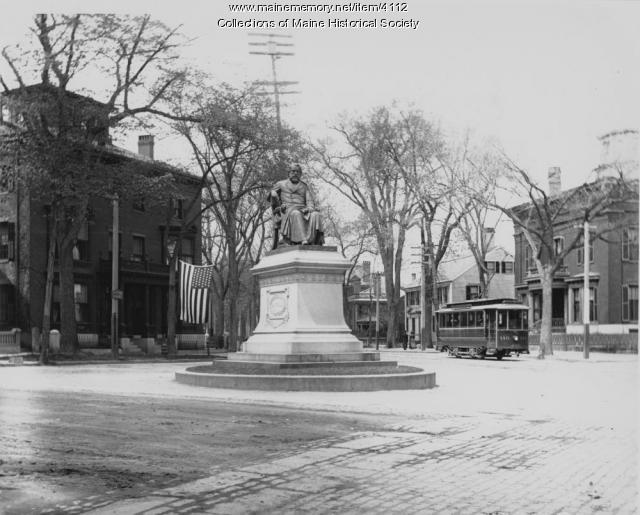Keywords: graduations
Item 110702
Farmington Normal School graduates, 1928
Contributed by: Mantor Library at UMF Date: 1928 Location: Farmington Media: photographic print
Item 81258
Tuscan Opera House Stage, Dixfield, 1933
Contributed by: Dixfield Historical Society Date: 1933 Location: Dixfield Media: Photographic print
Item 151221
The Mount, Lenox, Massachusetts, 1980-1999
Contributed by: Maine Historical Society Date: 1980–1999 Location: Lenox Client: The Mount, Edith Wharton's Home Architect: Patrick Chasse; Landscape Design Associates
Item 151390
Meredith College music building, Raleigh, North Carolina, 1978
Contributed by: Maine Historical Society
Date: 1978
Location: Raleigh
Client: Meredith College
Architect: Carol A. Wilson; Carol A. Wilson Architect
This record contains 8 images.
Exhibit
Graduations -- and schools -- in the 19th through the first decade of the 20th century often were small affairs and sometimes featured student presentations that demonstrated what they had learned. They were not necessarily held in May or June, what later became the standard "end of the school year."
Exhibit
Bowdoin College Scientific Expedition to Labrador
"The Bowdoin Boys" -- some students and recent graduates -- traveled to Labrador in 1891 to collect artifacts, specimens, and to try to find Grand Falls, a waterfall deep in Labrador's interior.
Site Page
Presque Isle: The Star City - Graduates, Gouldville Elementary, Presque Isle, 1922
"Graduates, Gouldville Elementary, Presque Isle, 1922 Contributed by Presque Isle Historical Society Description A group photo of the…"
Site Page
View collections, facts, and contact information for this Contributing Partner.
Story
My Involvement in Maine sports over the years
by Dick Whitmore
The key people and influences in my life growing up and my involvement in Maine sports
Story
From Istanbul to Machias
by Zeynep Turk
Zeynep Turk talks about moving from Istanbul, Turkey to Machias, Maine for school.
Lesson Plan
Longfellow Studies: Henry Wadsworth Longfellow & Harriet Beecher Stowe
Grade Level: 9-12
Content Area: Social Studies
As a graduate of Bowdoin College and a longtime resident of Brunswick, I have a distinct interest in Longfellow. Yet the history of Brunswick includes other famous writers as well, including Harriet Beecher Stowe. Although they did not reside in Brunswick contemporaneously, and Longfellow was already world-renowned before Stowe began her literary career, did these two notables have any interaction? More particularly, did Longfellow have any opinion of Stowe's work? If so, what was it?
Lesson Plan
Longfellow Studies: An American Studies Approach to Henry Wadsworth Longfellow
Grade Level: 6-8, 9-12
Content Area: English Language Arts, Social Studies
Henry Wadsworth Longfellow was truly a man of his time and of his nation; this native of Portland, Maine and graduate of Bowdoin College in Brunswick, Maine became an American icon. Lines from his poems intersperse our daily speech and the characters of his long narrative poems have become part of American myth. Longfellow's fame was international; scholars, politicians, heads-of-state and everyday people read and memorized his poems. Our goal is to show that just as Longfellow reacted to and participated in his times, so his poetry participated in shaping and defining American culture and literature.
The following unit plan introduces and demonstrates an American Studies approach to the life and work of Longfellow. Because the collaborative work that forms the basis for this unit was partially responsible for leading the two of us to complete the American & New England Studies Masters program at University of Southern Maine, we returned there for a working definition of "American Studies approach" as it applies to the grade level classroom. Joe Conforti, who was director at the time we both went through the program, offered some useful clarifying comments and explanation. He reminded us that such a focus provides a holistic approach to the life and work of an author. It sets a work of literature in a broad cultural and historical context as well as in the context of the poet's life. The aim of an American Studies approach is to "broaden the context of a work to illuminate the American past" (Conforti) for your students.
We have found this approach to have multiple benefits at the classroom and research level. It brings the poems and the poet alive for students and connects with other curricular work, especially social studies. When linked with a Maine history unit, it helps to place Portland and Maine in an historical and cultural context. It also provides an inviting atmosphere for the in-depth study of the mechanics of Longfellow's poetry.
What follows is a set of lesson plans that form a unit of study. The biographical "anchor" that we have used for this unit is an out-of-print biography An American Bard: The story of Henry Wadsworth Longfellow, by Ruth Langland Holberg, Thomas Y. Crowell & Company, c1963. Permission has been requested to make this work available as a downloadable file off this web page, but in the meantime, used copies are readily and cheaply available from various vendors. The poem we have chosen to demonstrate our approach is "Paul Revere's Ride." The worksheets were developed by Judy Donahue, the explanatory essays researched and written by the two of us, and our sources are cited below. We have also included a list of helpful links. When possible we have included helpful material in text format, or have supplied site links. Our complete unit includes other Longfellow poems with the same approach, but in the interest of time and space, they are not included. Please feel free to contact us with questions and comments.


















